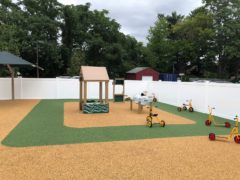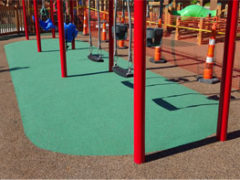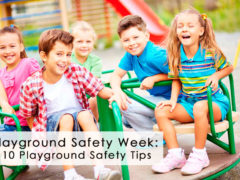
According to the CDC, about one in six children aged 3 through 17 have one or more developmental disabilities. Developmental disabilities can cause physical, behavioral, verbal, or cognitive challenges for a child. These conditions often impact a child’s day-to-day life and can make even simple activities difficult.
At AdventureTurf, we firmly believe that recreation should be accessible to all – regardless of ability. It’s our goal to provide safe access to play spaces for every child so that they can share the basic childhood joys of the playground with their peers. We keep safety and inclusivity at the forefront of all we do.
Our playground surfacing design and installation allows safe access to ground-level play components that are wheelchair accessible. We use beveled edges to make every accessible playground compliant with ADA standards. Whether you want to renovate existing play areas or construct a new inclusive, and accessible playground, our professionals at AdventureTurf are here to guide you through the process.
What makes a playground accessible?
The Americans with Disabilities Act (ADA) established specific guidelines for a playground to be considered “accessible.” The ADA requires that any new or existing playground at government buildings, public facilities, and commercial installations meet accessibility standards for individuals with disabilities.
The goal of an inclusive and accessible playground is to give every child the chance to enjoy the play equipment with their peers in a safe way, regardless of their physical abilities. Accessible play spaces focus on eliminating barriers that may prevent a child in a wheelchair or other mobility device from easily navigating to playground equipment. An accessible design for a newly constructed playground considers wheelchair maneuverability at each point of the design process.
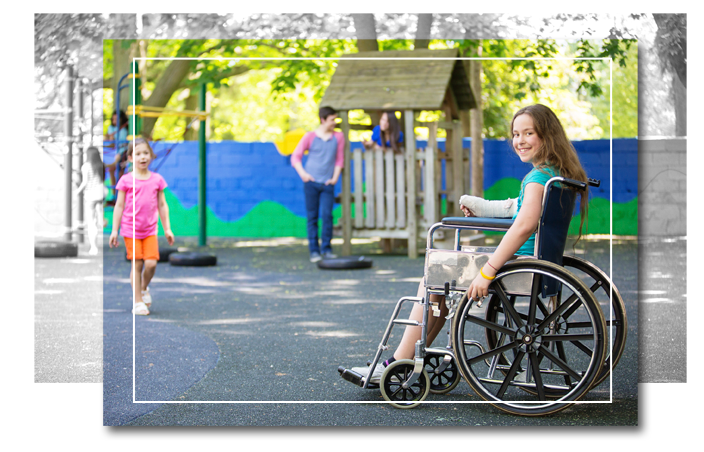
A well-designed playground includes accessible play components that are easy for children who use wheelchairs to reach. This usually includes accessible ground routes, a firm ramp surface, transfer systems, and unitary playground surfacing.
AdventureTurf helps create accessible, safe playgrounds with our expertise and attention to detail at every step. If you are seeking to make a wheelchair-accessible playground, here are 6 important things to consider.
#1 Site Selection and Playground Planning
An inclusive playground starts with a carefully considered design. When selecting the play equipment, it is just as important to map out how people should enter and move around the site. An accessible route gives all users equal access regardless of ability or mobility level.
Site plans should detail the proposed accessible route because even though a site appears flat, it may exceed the maximum slope to be an ADA-compliant path. We diligently keep track of all playground components during the surface installation process. Playground equipment is sometimes relocated during construction and changes from the initial plan, which results in wheelchair paths that are not ADA-compliant. We ensure that site plans show designated areas of entry and egress connected between all elevated play components, ground-level elements, and every type of substrate and loose-fill surfacing materials.
#2 Know the ADA standards for accessible playgrounds
- There must be an accessible path to the playground that allows easy access for a wheelchair or mobility device
- There must be a ground-level play component of every type present on the playground
- At least half of the elevated play equipment must be on a wheelchair-accessible path
- Ramps in accessible play areas must have handrails on each side
- Seating must offer easy access and transfer from a mobility device
- Surfacing that complies with ASTM 1951 (Determination of Accessibility of Surface Systems Under and Around Playground Equipment)
#3 Compare Surface Options
adventureTURF offers numerous options for ADA-compliant playground surfacing. Each has its merits, and we can help you determine which surfacing is right for you.
Poured Rubber Playground Surfacing
Also called “wet pour rubber flooring,” “rubberized playground surfacing,” “safety flooring for playgrounds,” or “playground base.”
- Pros: most durable, permanent surface option, low maintenance, customizable for depth, color, shape, and design. It’s also a soft surface, making it very safe.
- Cons: Typically this type of surface will last 10-15 years with proper maintenance. But, PIP rubber can wear out over time. After a simple evaluation, surface wear and tear issues can usually be resolved quickly and inexpensively.

Rubber Tiles
- Pros: Shock-absorbent and safe for falls from 6 feet (for 2.5-inch rubber tiles) up to 8 feet (for 4.25-inch tiles), suitable for those with skin sensitivities and allergies. These materials are free of metal, wood, harsh chemicals, and other irritating materials. The non-porous texture means it remains a non-slip surface even when wet.
- Cons: If not installed properly, the grooves/edges of the tiles could create a tripping hazard.
Bonded Rubber Mulch
- Pros: Can protect from falls up to 10 feet, depending on the exact product and depth used. Its unitary surface makes bonded rubber a better playground flooring choice than common loose-fill materials like shredded rubber mulch, wood chips, sand, engineered wood fiber, pea gravel, or dirt/grass. It is also resistant to acquiring embedded debris.
- Cons: Pieces can become unglued and loose. Also, bonded rubber mulch typically only consists of a single surfacing layer.
Artificial Grass/Turf
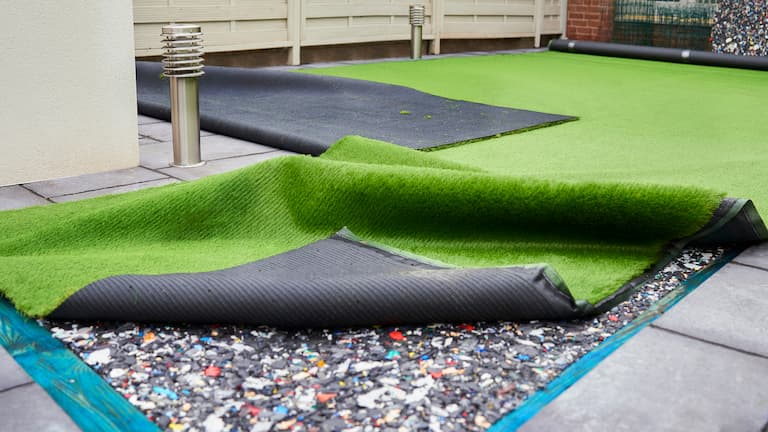
- Pros: If the artificial grass is firm and a wheelchair can easily move around it, you can use synthetic grass for accessible playgrounds that are ADA-compliant. It works well for people with grass allergies. Artificial turf with a thickness of 2.1-3.1″ achieves a fall height safety factor of five feet. A thickness of 3.3-4.3″ achieves a height of seven feet, which is recommended for most residential and commercial playgrounds.
- Cons: Certain types of artificial turf may not absorb falls from as high as poured-in-place surfacing. Synthetic turf may need additional padding or underlayment to keep kids safe and achieve the proper fall-height rating. Confirming the specific product’s details is essential to ensure it is safe for an accessible playground.
Pavement
- Pros: While concrete and asphalt playground pavement surfaces are ADA-compliant for ramps and flooring, it is not appropriate to use underneath playground equipment. If you choose playground pavement, opt for a play space with a tactical experience, adding textures like rumble strips or undulations to concrete or asphalt surfaces. Children with special needs can benefit from play that stimulates their sense of touch.
- Cons: Concrete has almost no shock absorbency, so it does not meet ASTM standards for fall height. This means concrete is unsafe for use directly under play structures. A severe head injury can occur due to a fall from the equipment. Wear and weather can also create cracks in the surface, posing a safety hazard and making wheelchair navigation difficult.
#4 Know the Playground Safety Standards for Inspection
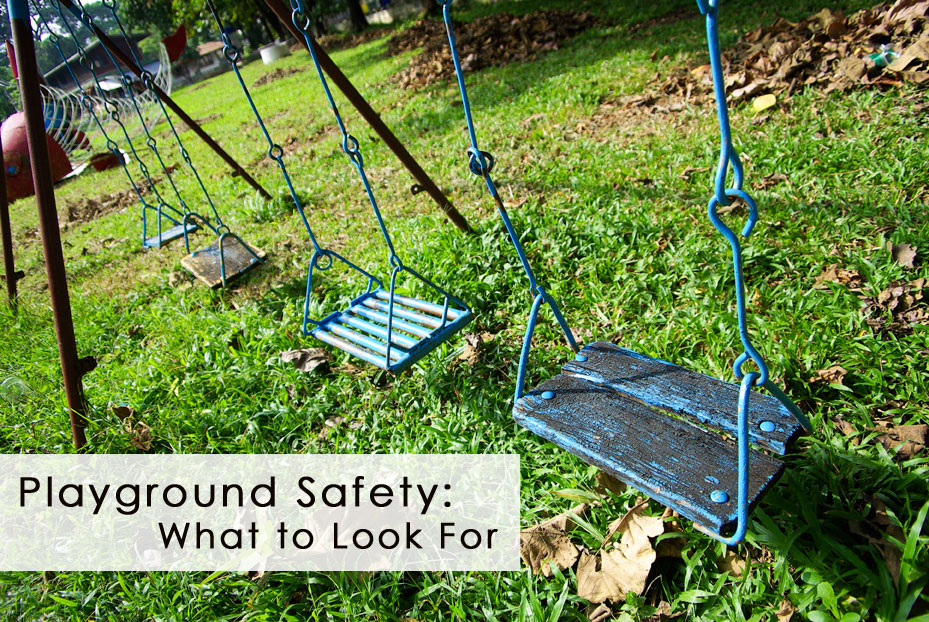
As a playground owner, you must know that your wheelchair-accessible playground meets safety standards. Playground safety is essential for every child, but children with special needs need special attention to safety. The Consumer Product Safety Commission (CPSC) lays out guidelines that all public playgrounds must adhere to.
- Playground surfacing surrounding the play equipment must have at least 12 inches of wood chips, mulch, sand, pea gravel, or rubber mats.
- Protective surfacing must extend at least 6 feet in every direction from play equipment. If you have a swing set at your facility, the surrounding surfacing must be twice the height of the suspending bar.
- Your accessible play structures that are more than 30 inches high must be spaced at least 9 feet apart.
- Avoid hardware that could potentially cause injuries, such as open “S” hooks or protruding bolt ends.
- Make sure spaces where children could get stuck, such as openings in guardrails or between ladder rungs, are less than 3.5 inches or more than 9 inches.
- There should be no sharp edges or points on any of the play equipment.
- Look out for tripping hazards, like exposed concrete footings, tree stumps, and rocks.
- Make sure elevated surfaces, like platforms and ramps, have guardrails to prevent falls.
- Inspect the playground regularly to ensure play equipment and surfacing are in good condition.
- Children must always be supervised while on the playground.
The surface material around and under accessible playground equipment plays a vital role in reducing the risk of life-threatening head injuries. A shock-absorbing surface is less likely to cause serious harm compared to a hard surface. However, it’s important to realize that falls can still result in injuries, regardless of the surface material used.
#5 Recognize that Proper Installation of Play Surface Systems is Key
Professional expert installation of your playground surface is critical to ensure its safety and longevity. When the playground surface is installed, an on-site inspection of the surfacing should be conducted along the accessible routes, at the clear ground spaces for entry or egress of the equipment, and at any turning spaces.
When we install your surfacing, we will measure the running slope and cross slope to make sure they are wheelchair-accessible. All playground equipment must meet our high standards of firmness and stability, and we are meticulous in ensuring there are no gaps in the surfacing that could pose a problem for wheelchairs.
#6 Understand How to Maintain Your Accessible Playground
Regardless of which surfacing material you choose, regular maintenance is vital to having a safe and accessible playground. Basic maintenance includes inspection, cleaning, and repair when necessary. Regular visual inspections and simple cleaning can help ensure it remains safe for children at play. Start by sweeping away dirt with a soft-bristled broom or leaf blower, but avoid stiff bristles that could cause damage to the surfacing.

You may also use an appropriate product to sanitize your unitary surface against germs and bacteria. For more extensive repair work, speak to our professionals at AdventureTurf who specialize in restoring these surfaces back into great condition. These precautionary steps ensure your wheelchair-accessible playground stays safe and enjoyable for everyone!
Accessible and Inclusive Playground FAQ
For most of our customers, having wheelchair-accessible equipment is a top priority. Here are some of the most common questions we hear from clients:
What is an inclusive playground?
Just because a playground is labeled as accessible doesn’t guarantee inclusivity. While traditional playgrounds are not accessible to children of varying abilities, inclusive playgrounds are designed to be fun for all kids. An inclusive play area means children with wheelchairs, walkers and other mobility devices can play alongside their peers and gain the same social skills, sensory stimulation and motor skills as their friends.
No child feels left out when kids play together using inclusive playground equipment. This is why it’s crucial for playground equipment to be both accessible and inclusive. Our playground surfacing includes safe ground-level components, beveled edges, and smooth, accessible routes for wheelchairs and walkers. We take pride in creating surfacing for accessible and inclusive play areas. Our surfaces are carefully crafted to ensure a safe and enjoyable experience for all.
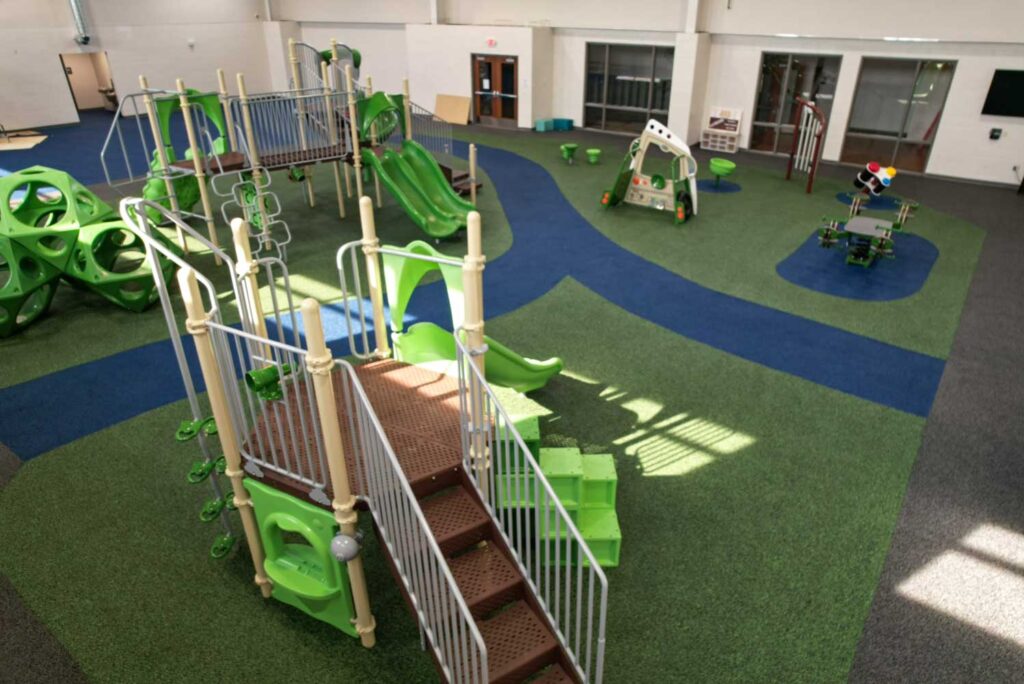
What surfacing materials cannot be used for a wheelchair-accessible playground?
Asphalt, carpeting not tested to ASTM standards, concrete, dirt, grass, and CCA-treated wood mulch are not approved for a wheelchair-accessible playground according to the Handbook for Public Playground Safety. AdventureTurf offers many safe alternatives and we can help you find the perfect material for your playground.
What is an acceptable loose surface material for playgrounds?
If you are looking for surfacing to use with wheelchair-accessible playground equipment, loose surface materials are not the best option. If you do opt for a loose material for your play space, the best option is Engineered Wood Fiber (EWF), which is ADA-approved.
What is the ASTM standard for playground surfacing?
The ASTM (American Society for Testing and Materials) standard 1292 applies to all surfacing materials used at a playground. Each surfacing type has its own ASTM standard that specifies requirements unique to the material, such as the method of installation, particle size, and water drainage. It measures the firmness of playground surfacing and the risk of life-threatening fall injuries from various heights.
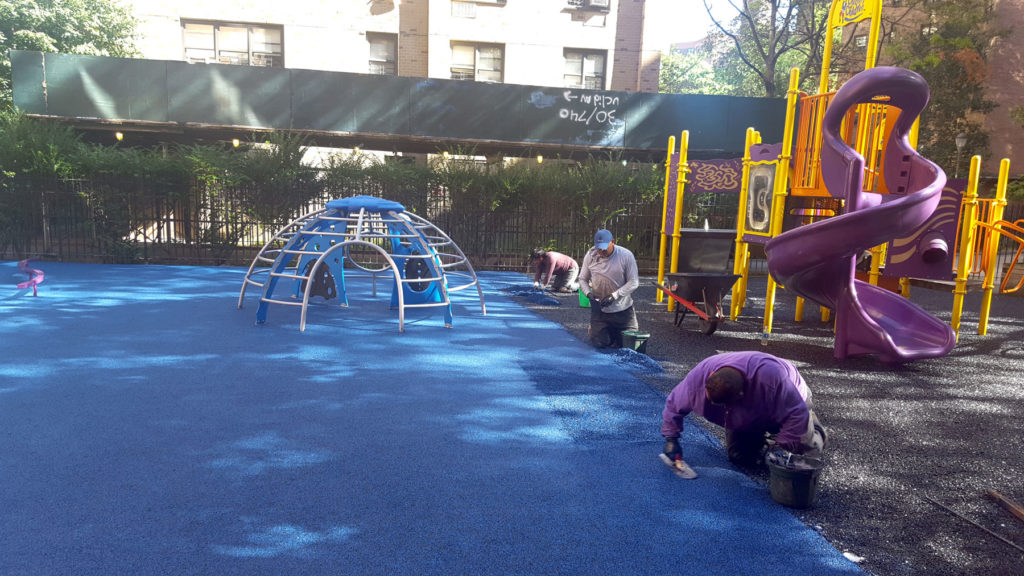
AdventureTurf makes sure all our surfacing is ASTM 1292 certified. ASTM 1951 is specific to accessible playgrounds, and it is required by law because it is a part of the Americans with Disabilities Act (ADA).
What is recommended to use as a fall surface on a children’s playground?
Falls are the most common reason for playground injuries, making up an estimated 44%, according to the CPSC. Each surface material has a “critical height,” an approximation of the maximum fall height where a life-threatening head injury would not likely occur. The fall height of a piece of playground equipment is the distance from the highest play surface on the equipment to the protective surface beneath it. The critical height rating of the surfacing material should be greater than or equal to the fall height of the highest piece of playground equipment. At AdventureTurf, we will help you determine the proper fall surfacing based on the equipment at your playground.
Give all kids access to adventures of fun with AdventureTurf!
Contact us today to see how our great surfacing options and professional installation can make your playground an amazing place to play for everyone!
